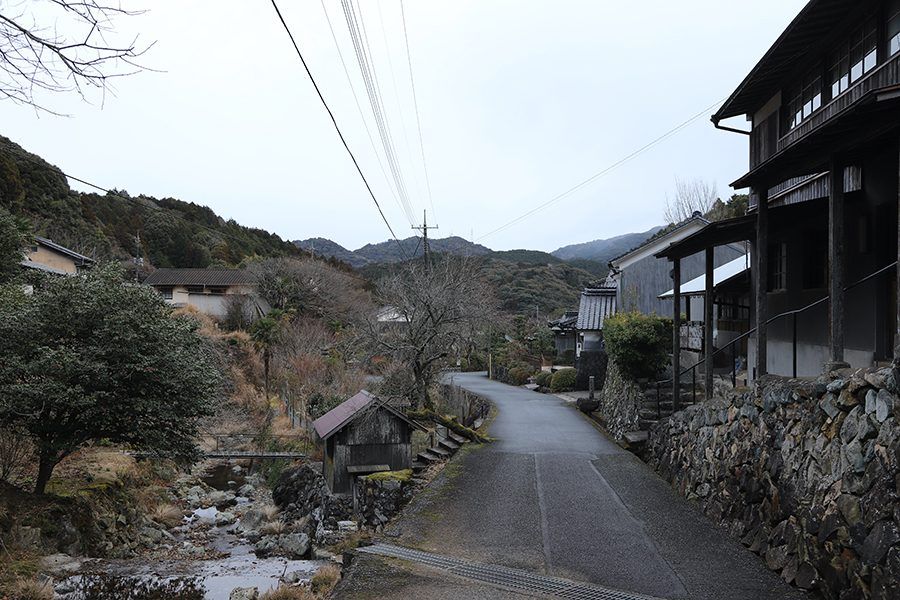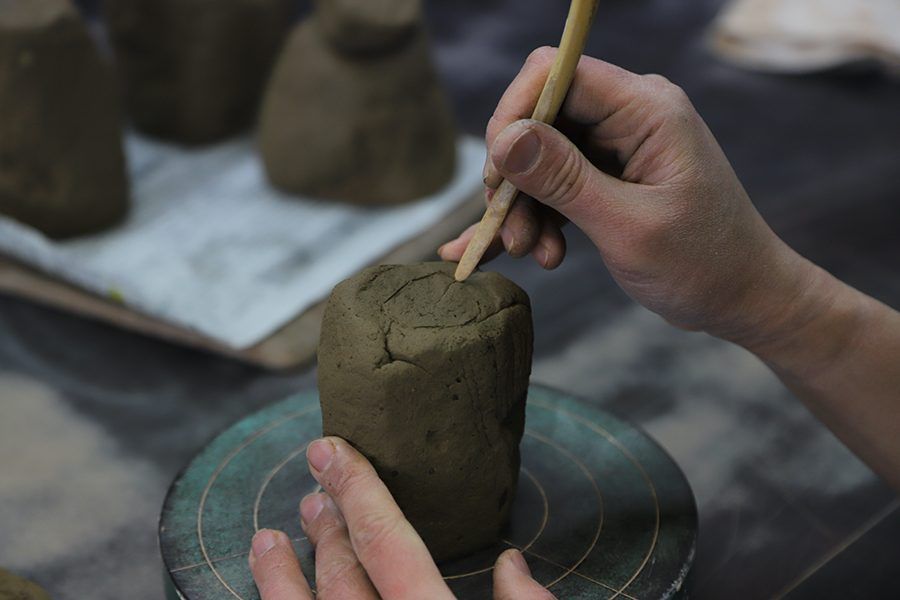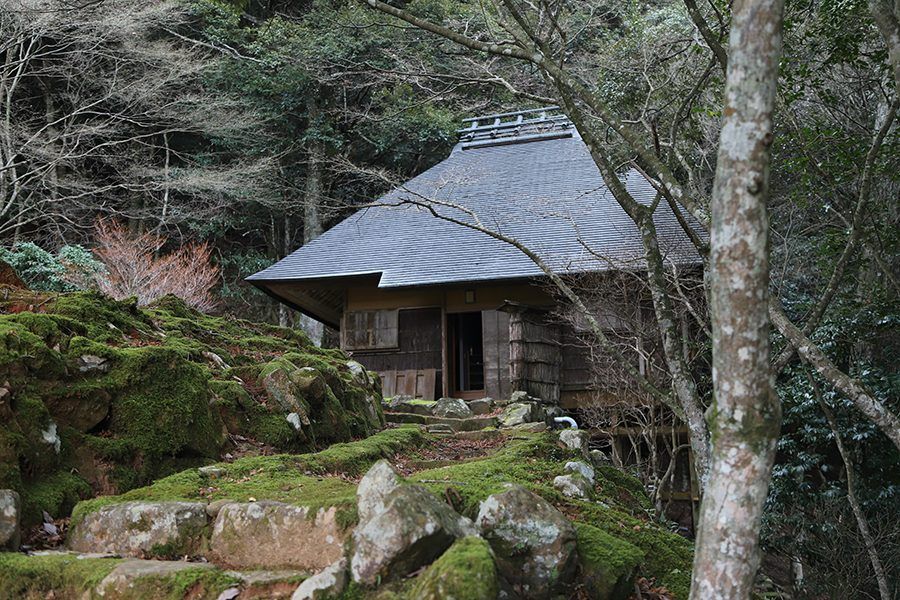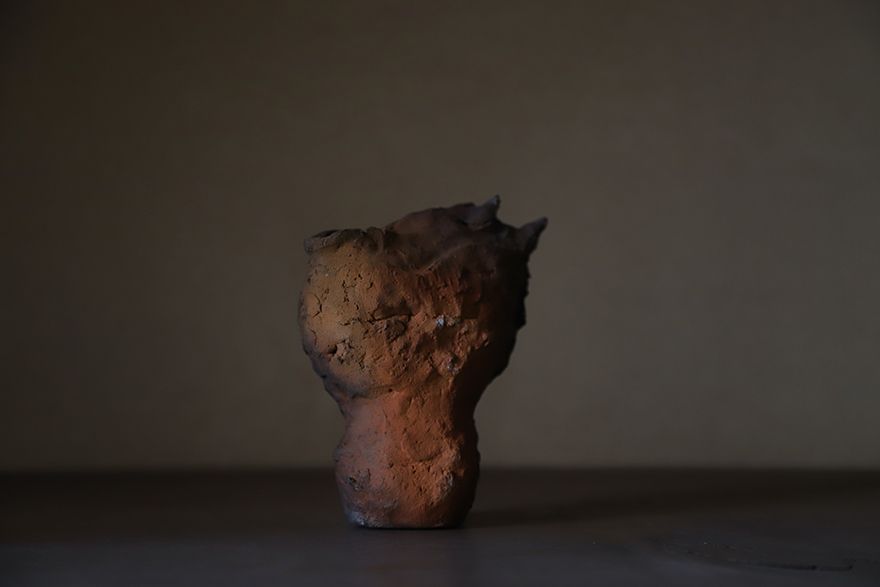
山口県長門市深川湯本三之瀬 坂倉新兵衛窯 坂倉正紘Fukawa Yumoto Sannose, Hagi City, Yamaguchi Prefecture
Masahiro Sakakura, Sakakura Shinbe Kiln
山口県一帯で作られ、日本を代表する焼き物のひとつである萩焼。土と釉薬、火加減による景色や、ふっくらと柔らかな感触、茶渋を吸い込んだ貫入の色の変化が特徴です。人の手を入れすぎず自然に任せた多様で豊かな土の表情が古来より多くの茶人を魅了し「一楽、二萩、三唐津」ともいわれるほど、深く愛されてきました。その歴史は、豊臣秀吉が朝鮮に出兵した文禄、慶長の役(1592〜1598年)の折、萩藩主毛利輝元公が朝鮮李朝の陶工、李勺光・李敬を日本に招致し、萩城下の松本(現在の萩市椿東)と、50年程後には深川三之瀬(長門市深川湯本三之瀬)に御用窯を築いて高麗茶碗の技術を伝えたことに始まり、独自の発展を遂げながら長い歴史を経て今日まで続いています。

600年前に発見されたといわれる温泉郷長門湯本の山間に5軒の窯元が残る深川三之瀬。澄んだ空気と川の流れ、苔むした岩、夏蜜柑の木、点在する工房を眺めながら坂道を登っていくと、一番奥にあるのが坂倉新兵衛窯です。案内してくださった坂倉正紘さんは、大学時代に東京で彫刻を学び、その後京都で陶芸を学んだのち故郷に戻り、父である当代十五代目坂倉新兵衛さんのもとで作陶されています。

15代坂倉新兵衛氏 手捏ねの茶碗
Hand-crafted tea bowl by the 15th Shinbe Sakakura
「この場所で暮らし、土を掘り、焼いているのでどうやっても萩焼になる、と広く捉えて自分が作りたいと思うものを作っています」という坂倉さん。この土地や歴史の恩恵を大きく受けていることを強く実感はするものの、伝統を重荷と感じることはあまりないそうです。「ここにいると昔から人々が山や太陽を神としてきたのがわかります」との言葉通り、作品には素材から受け取る感覚がそのまま映し出されたような風や川の優美な流れやうねり、太陽や土の持つ野性味や温かさがあり、釉薬と炎による豊かな土の表情に連綿と続く萩焼の精神を宿しながらも、今ここに存在するものの息吹を感じます。

「石くれ」と名づけた茶入。粘土を岩にぶつけて質感を出す。土を削り出す道具は竹を取り手作りしたもの。このカーブがちょうどいい。
A tea container titled Ishi-kure. The clay is smashed against a rock to give it texture. The tool used to sculpt the clay is handmade from bamboo. This curve is just right.
2017年にはcafé&pottery音を立ち上げ、陶芸家やデザイナーなど5人の共同店主とともに萩焼をはじめ長門湯本温泉の街や自然の魅力を伝え、旅人や移住者と地元の人、作り手と使い手、さまざまな交流が生まれる新たな場作りもしている坂倉さん。暮らしの器からオブジェまで、幅広く作陶されていますが、一番作りたいものは、やはり茶碗だといいます。「茶碗は自由ですが何をしてもいいわけではなくて、茶道の“様式”、お茶を飲むという“用”、手におさまる“形”という三つの縛りがあり、そこに作り手と使い手の美意識が現れます。この縛りがあるからこそ長い年月を超えて深く追求していけるのではないかと思います」。

敷地内に祀られた大きな松の切り株の傍ら建てられた「吟松亭」という名の茶室。
A tea house called Ginsho-tei is built beside a large pine tree stump enshrined in the grounds of the Kiln.
Hagi ware has been produced all over Yamaguchi Prefecture, and is one of Japan’s most famous pottery styles. Hagi ware is characterised by its clay, glaze, and colour depending on the heat. It is also defined by its plump and soft texture, and the changing colour of the crack-like glaze as it absorbs the tea stain. Hagi ware has been loved by many tea masters since ancient times for its rich and diverse expressions of clay, which is left to nature without too much human intervention, and is often referred to as “First Raku, second Hagi, third Karatsu (*)”. The history of Hagi ware can be traced back to the time when MORI Terumoto, Lord of the Hagi clan, invited 2 potters from Joseon Dynasty Korea, LEE Jak Kwang and LEE Kyung, to Japan during TOYOTOMI Hideyoshi’s Japanese Invasion of Korea (1592-98). It began when MORI built kilns for his clan in Matsumoto, the town of Hagi Castle (present day Chinto in Hagi City), and in Fukawa-sonose (present day Sonose, Fukawa-yumoto in Nagato City) about 50 years later, where the technique of Korean Koryo-dynasty tea bowls was introduced. Hagi ware has then continued to develop in its own unique way over a long period of time to the present day.
Fukawa-sonose is where 5 kilns remain in the mountains of Nagato-yumoto, a hot spring village said to have been discovered 600 years ago. If you walk up the slope looking at the clear air, the flowing river, the mossy rocks, the summer tangerine trees and the scattered pottery studios, you will find the Sakakura Shinbei-gama Kiln at the far end. Masahiro Sakakura, who showed us around the studio, studied sculpture at a university in Tokyo, and later studied pottery in Kyoto before returning to his hometown to work under his father, Shinbe Sakakura, the 15th generation master. “As I live here, dig the soil and make the pottery, no matter how I do it, what I make will always become Hagi ware. Taking things broadly like that, I am making what I want to make,” says Masahiro. Although he feels strongly that he benefits greatly from the land and its history, he doesn’t feel burdened by tradition. As he says, “When I am here, I can see how people have long regarded the mountains and the sun as divinity.” His work reflects the sensations he receives from the materials: the graceful flow and swell of the wind and river, the wildness and warmth of the sun and soil. While holding the spirit of Hagi ware within the rich texture of the soil given by the glaze and the fire, there is a breath of what exists here and now.
In 2017, Masahiro opened Cafe & Pottery Oto. Together with 5 co-owners, including potters and designers, he has been creating a new place where they promote the charms of Hagi ware, and the town and nature of Nagato Yumoto Onsen, while fostering exchange between travellers, migrants, locals, makers and users. He makes a wide range of pottery, from daily utensils to objets d’art, but the thing he wants to make the most is tea bowls. Masahiro says, “There is a freedom in tea bowls, but it does not mean that you can do anything with them. There are 3 constraints: “the style” of the tea ceremony, “the use” of drinking tea, and “the shape” that fits in the hands. And this is where the aesthetic sense of the maker and the user comes into play. I think it is precisely because of these constraints that we are able to pursue them so deeply over the years.”

台ノ土茶盌 大道粉引 Hagi Dai-no-tsuchi Tea Bowl, Daido-Kohiki Style

急須 Teapot

拝日の徒 Worshipper of the Sun

vanishment

pieces‐pottery

萩茶盌 大道粉引 Hagi Tea Bowl, Daido-Kohiki Style
Photography by Tomoko Hayashi
Text by Tomomi Takezoe
Translation :Naoko Mabon (WAGON)


